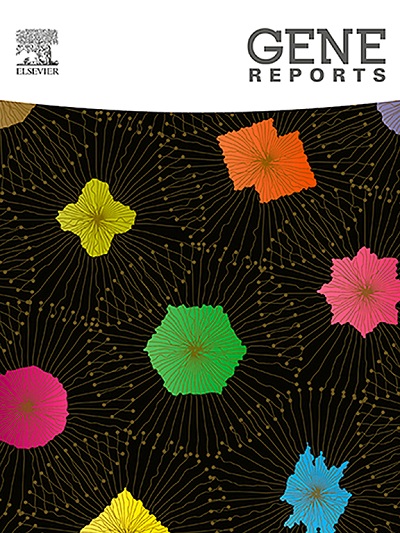Comparative evaluation of macrophage polarization markers- nitric oxide, sCD163 and miRNA-21 in the saliva of healthy, gingivitis and periodontitis patients with and without type 2 diabetes mellitus: A case-control study
IF 1
Q4 GENETICS & HEREDITY
引用次数: 0
Abstract
Background
M1/M2 macrophage phenotypes are crucial for periodontal tissue homeostasis, and their balance is modulated by micro-RNAs. This study sought to assess the potential of nitric oxide (NO), sCD163, and miRNA-21 to serve as diagnostic biomarkers.
Materials and methods
52 subjects categorised into 4 groups - Group A: systemically and periodontally healthy; Group B: systemically healthy with gingivitis; Group C: Stage- III or IV Periodontitis without Type 2 Diabetes Mellitus(T2DM) and Group D: stage III/IV periodontitis with T2DM.Saliva was analyzed for sCD163 using ELISA, NO by colorimetric assay and miRNA-21 by real time qPCR.
Results
Group C and D had higher concentration of sCD163 and NO, when compared to Groups A and B with the difference being statistically significant (p < 0.001). The miRNA-21 CT values were highest in group B while it was lowest in group D, with this difference being significant (p < 0.001). Higher miRNA-21 fold change was seen in group C which however was not statistically significant on comparing between the groups. sCD163 and NO values showed a positive correlation and miRNA-21 CT values showed a negative correlation with clinical parameters which was statistically significant (p < 0.05). sCD163 and NO showed a significant positive correlation with each other, whereas miRNA-21 CT showed significant negative correlation with sCD163 (p < 0.05).
Conclusions
Dysregulated macrophage polarization may play a prime role in the pathogenesis of periodontitis with or without diabetes mellitus. sCD163, NO, and miRNA-21 could be potential diagnostic biomarkers for evaluating macrophage polarization and periodontitis severity, which will however need to be confirmed through longitudinal trials.

健康人、牙龈炎和牙周炎合并和不合并2型糖尿病患者唾液中巨噬细胞极化标志物一氧化氮、sCD163和miRNA-21的比较评价:一项病例对照研究
巨噬细胞m1 /M2表型对牙周组织稳态至关重要,它们的平衡是由微rna调节的。本研究旨在评估一氧化氮(NO)、sCD163和miRNA-21作为诊断性生物标志物的潜力。材料与方法52例受试者分为4组:A组:全身和牙周健康;B组:全身健康,伴有牙龈炎;C组:无2型糖尿病(T2DM)的III期或IV期牙周炎;D组:伴有T2DM的III/IV期牙周炎。ELISA法检测唾液sCD163,比色法检测NO,实时荧光定量pcr检测miRNA-21。结果C、D组sCD163、NO浓度高于A、B组,差异有统计学意义(p <;0.001)。B组miRNA-21 CT值最高,D组最低,差异有统计学意义(p <;0.001)。C组miRNA-21倍变化较高,组间比较差异无统计学意义。sCD163与NO值呈正相关,miRNA-21 CT值与临床参数呈负相关,差异有统计学意义(p <;0.05)。sCD163与NO呈显著正相关,而miRNA-21 CT与sCD163呈显著负相关(p <;0.05)。结论巨噬细胞极化失调可能在伴有或不伴有糖尿病的牙周炎发病中起主要作用。sCD163、NO和miRNA-21可能是评估巨噬细胞极化和牙周炎严重程度的潜在诊断性生物标志物,但这需要通过纵向试验来证实。
本文章由计算机程序翻译,如有差异,请以英文原文为准。
求助全文
约1分钟内获得全文
求助全文
来源期刊

Gene Reports
Biochemistry, Genetics and Molecular Biology-Genetics
CiteScore
3.30
自引率
7.70%
发文量
246
审稿时长
49 days
期刊介绍:
Gene Reports publishes papers that focus on the regulation, expression, function and evolution of genes in all biological contexts, including all prokaryotic and eukaryotic organisms, as well as viruses. Gene Reports strives to be a very diverse journal and topics in all fields will be considered for publication. Although not limited to the following, some general topics include: DNA Organization, Replication & Evolution -Focus on genomic DNA (chromosomal organization, comparative genomics, DNA replication, DNA repair, mobile DNA, mitochondrial DNA, chloroplast DNA). Expression & Function - Focus on functional RNAs (microRNAs, tRNAs, rRNAs, mRNA splicing, alternative polyadenylation) Regulation - Focus on processes that mediate gene-read out (epigenetics, chromatin, histone code, transcription, translation, protein degradation). Cell Signaling - Focus on mechanisms that control information flow into the nucleus to control gene expression (kinase and phosphatase pathways controlled by extra-cellular ligands, Wnt, Notch, TGFbeta/BMPs, FGFs, IGFs etc.) Profiling of gene expression and genetic variation - Focus on high throughput approaches (e.g., DeepSeq, ChIP-Seq, Affymetrix microarrays, proteomics) that define gene regulatory circuitry, molecular pathways and protein/protein networks. Genetics - Focus on development in model organisms (e.g., mouse, frog, fruit fly, worm), human genetic variation, population genetics, as well as agricultural and veterinary genetics. Molecular Pathology & Regenerative Medicine - Focus on the deregulation of molecular processes in human diseases and mechanisms supporting regeneration of tissues through pluripotent or multipotent stem cells.
 求助内容:
求助内容: 应助结果提醒方式:
应助结果提醒方式:


